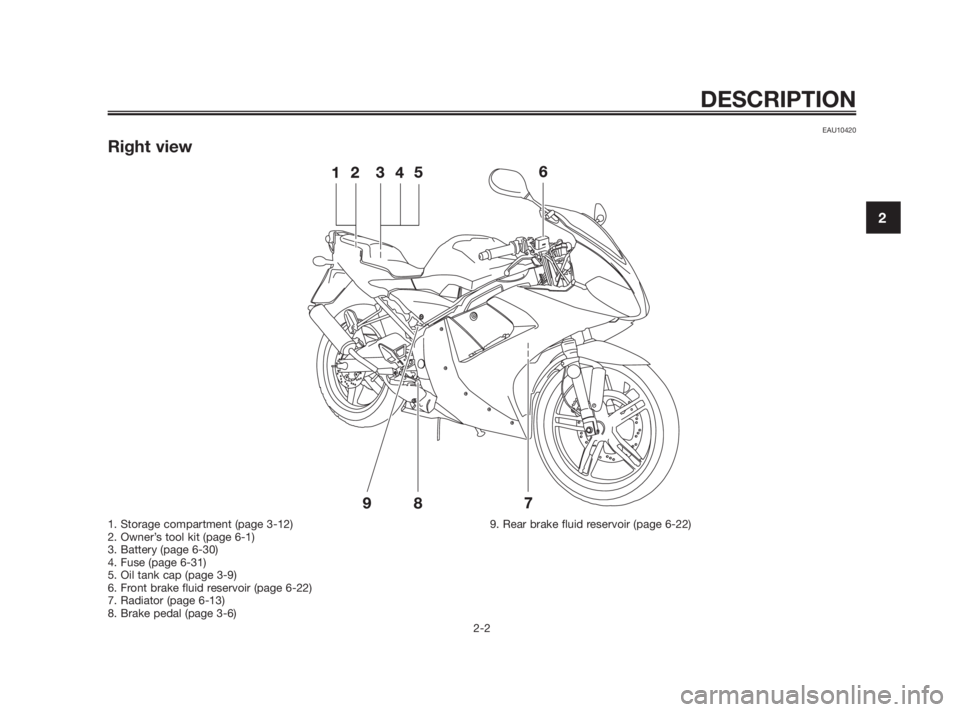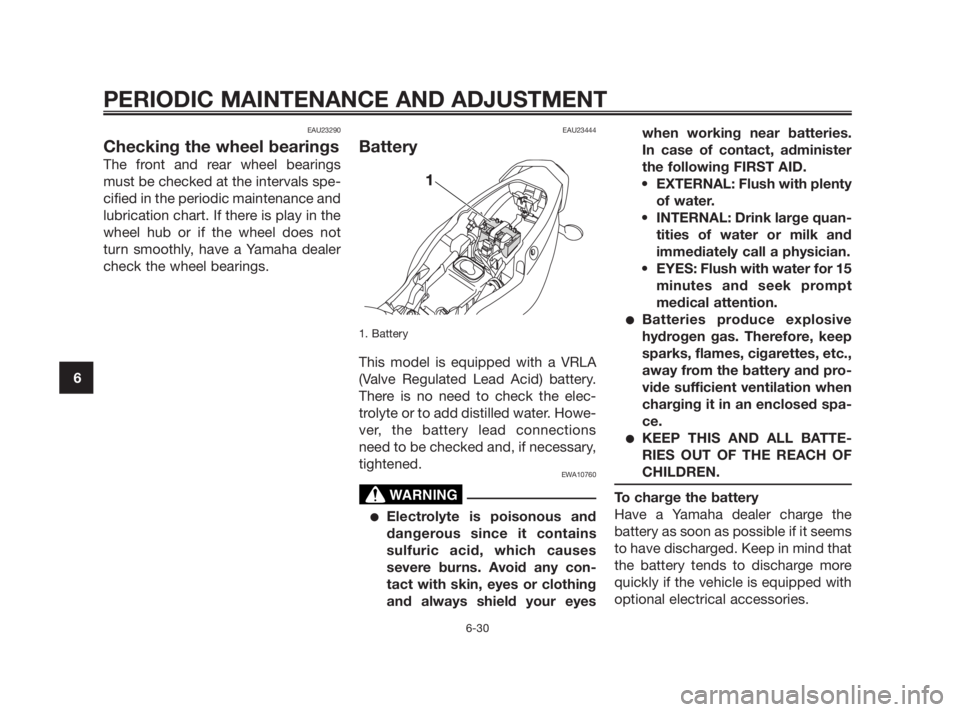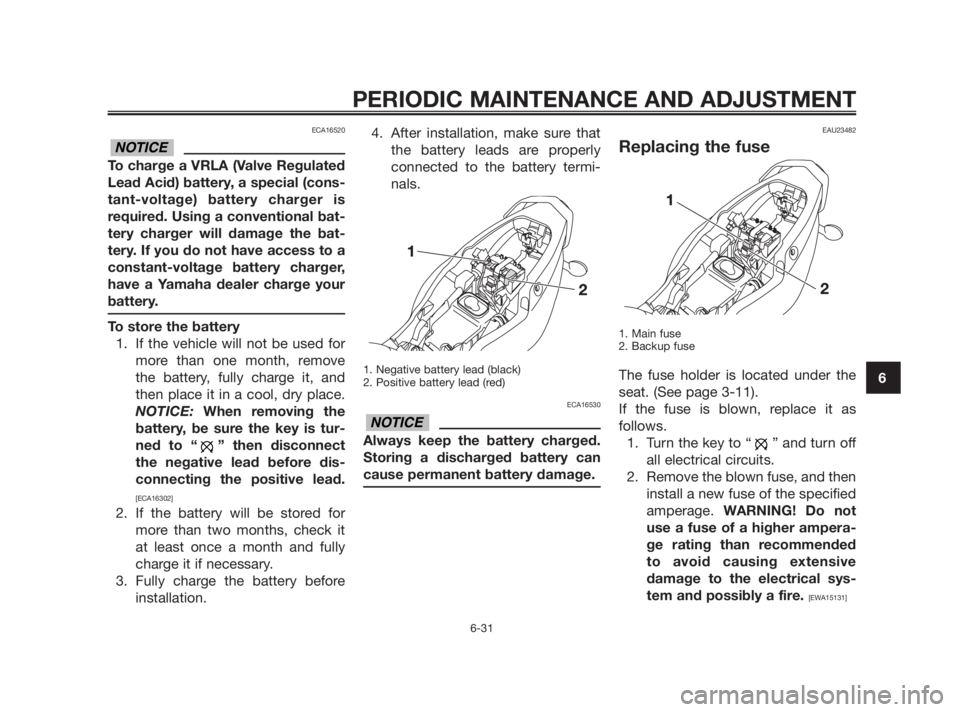2011 YAMAHA TZR50 battery
[x] Cancel search: batteryPage 7 of 88

Checking and lubricating the
cables ..........................................6-26
Checking and lubricating the throttle
grip and cable .............................6-26
Adjusting the Autolube pump .........6-27
Checking and lubricating the brake
and shift pedals ...........................6-27
Checking and lubricating the brake
and clutch levers .........................6-27
Checking and lubricating the
sidestand .....................................6-28
Checking the front fork ...................6-28
Checking the steering.....................6-29
Checking the wheel bearings .........6-30
Battery ............................................6-30
Replacing the fuse ..........................6-31
Replacing the headlight bulb..........6-32
Replacing the tail/brake light
bulb .............................................6-33
Replacing a front turn signal light
bulb .............................................6-34
Replacing a rear turn signal light
bulb .............................................6-34
Replacing the license plate light
bulb .............................................6-35
Troubleshooting ..............................6-36
Troubleshooting charts ...................6-37
MOTORCYCLE CARE AND
STORAGE ............................................7-1
Matte color caution...........................7-1Care ..................................................7-1
Storage .............................................7-3
SPECIFICATIONS ...............................8-1
CONSUMER INFORMATION .............9-1
Identification numbers ......................9-1
Key identification number .................9-1
Vehicle identification number............9-1
Model label .......................................9-2
TABLE OF CONTENTS
5WX-F819D-E3 15/11/08 15:27 Página 7
Page 13 of 88

EAU10420
Right view
DESCRIPTION
2-2
2
1. Storage compartment (page 3-12)
2. Owner’s tool kit (page 6-1)
3. Battery (page 6-30)
4. Fuse (page 6-31)
5. Oil tank cap (page 3-9)
6. Front brake fluid reservoir (page 6-22)
7. Radiator (page 6-13)
8. Brake pedal (page 3-6)9. Rear brake fluid reservoir (page 6-22)
5WX-F819D-E3 15/11/08 15:27 Página 13
Page 33 of 88

EAU15951
Read the Owner’s Manual carefully to
become familiar with all controls. If
there is a control or function you do
not understand, ask your Yamaha
dealer.
EWA10271
Failure to familiarize yourself with
the controls can lead to loss of
control, which could cause an acci-
dent or injury.
EAU16053
Starting a cold engine
In order for the ignition circuit cut-off
system to enable starting, one of the
following conditions must be met:
●The transmission is in the neutral
position.
●The transmission is in gear with
the clutch lever pulled and the
sidestand up.
See page 3-13 for more information.
1. Turn the fuel cock lever to “ON”.
2. Turn the key to “ ” and make
sure that the engine stop switch
is set to “ ”.
3. Shift the transmission into the
neutral position. (See page 5-2.)
The neutral indicator light should
come on. If not, ask a Yamaha
dealer to check the electrical cir-
cuit.
4. Turn the starter (choke) on and
completely close the throttle.
(See page 3-11).
5. Start the engine by pushing the
start switch.
If the engine fails to start, release
the start switch, wait a few
seconds, and then try again.Each starting attempt should be
as short as possible to preserve
the battery. Do not crank the
engine more than 10 seconds on
any one attempt.
6. After starting the engine, move
the starter (choke) back halfway.
NOTICE:For maximum engine
life, never accelerate hard
when the engine is cold!
[ECA11041]
7. When the engine is warm, turn
the starter (choke) off.
TIP
The engine is warm when it responds
normally to the throttle with the starter
(choke) turned off.
WARNING
OPERATION AND IMPORTANT RIDING POINTS
5-1
5
5WX-F819D-E3 15/11/08 15:27 Página 33
Page 66 of 88

EAU23290
Checking the wheel bearings
The front and rear wheel bearings
must be checked at the intervals spe-
cified in the periodic maintenance and
lubrication chart. If there is play in the
wheel hub or if the wheel does not
turn smoothly, have a Yamaha dealer
check the wheel bearings.
EAU23444
Battery
1. Battery
This model is equipped with a VRLA
(Valve Regulated Lead Acid) battery.
There is no need to check the elec-
trolyte or to add distilled water. Howe-
ver, the battery lead connections
need to be checked and, if necessary,
tightened.
EWA10760
●Electrolyte is poisonous and
dangerous since it contains
sulfuric acid, which causes
severe burns. Avoid any con-
tact with skin, eyes or clothing
and always shield your eyeswhen working near batteries.
In case of contact, administer
the following FIRST AID.
• EXTERNAL: Flush with plenty
of water.
• INTERNAL: Drink large quan-
tities of water or milk and
immediately call a physician.
• EYES: Flush with water for 15
minutes and seek prompt
medical attention.
●Batteries produce explosive
hydrogen gas. Therefore, keep
sparks, flames, cigarettes, etc.,
away from the battery and pro-
vide sufficient ventilation when
charging it in an enclosed spa-
ce.
●KEEP THIS AND ALL BATTE-
RIES OUT OF THE REACH OF
CHILDREN.
To charge the battery
Have a Yamaha dealer charge the
battery as soon as possible if it seems
to have discharged. Keep in mind that
the battery tends to discharge more
quickly if the vehicle is equipped with
optional electrical accessories.WARNING
PERIODIC MAINTENANCE AND ADJUSTMENT
6-30
6
5WX-F819D-E3 15/11/08 15:27 Página 66
Page 67 of 88

ECA16520
To charge a VRLA (Valve Regulated
Lead Acid) battery, a special (cons-
tant-voltage) battery charger is
required. Using a conventional bat-
tery charger will damage the bat-
tery. If you do not have access to a
constant-voltage battery charger,
have a Yamaha dealer charge your
battery.
To store the battery
1. If the vehicle will not be used for
more than one month, remove
the battery, fully charge it, and
then place it in a cool, dry place.
NOTICE: When removing the
battery, be sure the key is tur-
ned to “ ” then disconnect
the negative lead before dis-
connecting the positive lead.
[ECA16302]
2. If the battery will be stored for
more than two months, check it
at least once a month and fully
charge it if necessary.
3. Fully charge the battery before
installation.4. After installation, make sure that
the battery leads are properly
connected to the battery termi-
nals.
1. Negative battery lead (black)
2. Positive battery lead (red)
ECA16530
Always keep the battery charged.
Storing a discharged battery can
cause permanent battery damage.
EAU23482
Replacing the fuse
1. Main fuse
2. Backup fuse
The fuse holder is located under the
seat. (See page 3-11).
If the fuse is blown, replace it as
follows.
1. Turn the key to “ ” and turn off
all electrical circuits.
2. Remove the blown fuse, and then
install a new fuse of the specified
amperage. WARNING! Do not
use a fuse of a higher ampera-
ge rating than recommended
to avoid causing extensive
damage to the electrical sys-
tem and possibly a fire.
[EWA15131]
NOTICE
NOTICE
PERIODIC MAINTENANCE AND ADJUSTMENT
6-31
6
5WX-F819D-E3 15/11/08 15:27 Página 67
Page 73 of 88

EAU25922
Troubleshooting charts
Starting problems or poor engine performance
Check the fuel level in
the fuel tank.
1. FuelThere is enough fuel.
There is no fuel.Check the compression.
Supply fuel.
The engine does not start.
Check the compression.
Operate the electric starter.
2. CompressionThere is compression.
There is no compression.Check the ignition.
Have a Yamaha dealer
check the vehicle.
Remove the spark plug
and check the electrodes.
3. IgnitionWipe off with a dry cloth and correct the
spark plug gap, or replace the spark plug.
Have a Yamaha dealer check the vehicle.
The engine does not start.
Have a Yamaha dealer
check the vehicle.
The engine does not start.
Check the battery.
Operate the electric starter.
4. BatteryThe engine turns over
quickly.
The engine turns over
slowly.The battery is good.
Check the battery lead connections,
and charge the battery if necessary.
Dry
WetOpen the throttle halfway and operate
the electric starter.
PERIODIC MAINTENANCE AND ADJUSTMENT
6-37
6
5WX-F819D-E3 15/11/08 15:27 Página 73
Page 78 of 88

from building up. Pour the drai-
ned fuel into the fuel tank.
4. Fill up the fuel tank and add fuel
stabilizer (if available) to prevent
the fuel tank from rusting and the
fuel from deteriorating.
5. Perform the following steps to
protect the cylinder, piston rings,
etc. from corrosion.
a Remove the spark plug cap
and spark plug.
b Pour a teaspoonful of engine
oil into the spark plug bore.
c Install the spark plug cap
onto the spark plug, and then
place the spark plug on the
cylinder head so that the
electrodes are grounded.
(This will limit sparking during
the next step.)
d Turn the engine over several
times with the starter. (This
will coat the cylinder wall with
oil.)
e Remove the spark plug cap
from the spark plug, and then
install the spark plug and the
spark plug cap. WARNING!
To prevent damage or injuryfrom sparking, make sure
to ground the spark plug
electrodes while turning the
engine over.
[EWA10951]
6. Lubricate all control cables and
the pivoting points of all levers
and pedals as well as of the
sidestand/centerstand.
7. Check and, if necessary, correct
the tire air pressure, and then lift
the motorcycle so that both of its
wheels are off the ground. Alter-
natively, turn the wheels a little
every month in order to prevent
the tires from becoming degra-
ded in one spot.
8. Cover the muffler outlet with a
plastic bag to prevent moisture
from entering it.
9. Remove the battery and fully
charge it. Store it in a cool, dry
place and charge it once a
month. Do not store the battery in
an excessively cold or warm pla-
ce [less than 0 °C (30 °F) or more
than 30 °C (90 °F)]. For more
information on storing the bat-
tery, see page 6-30.
TIP
Make any necessary repairs before
storing the motorcycle.
MOTORCYCLE CARE AND STORAGE
7-4
7
5WX-F819D-E3 15/11/08 15:27 Página 78
Page 80 of 88

Chassis:Frame type:
Double cradle
Caster angle:
25.00 º
Trail:
90.0 mm (3.54 in)
Front tire:Type:
Tubeless
Size:
100/80 17 (52H)
Manufacturer/model:
Pirelli / Sport Demon
Manufacturer/model:
Continental/Conti-Twist SM
Rear tire:Type:
Tubeless
Size:
130/70 17 (62H)
Manufacturer/model:
Pirelli / Sport Demon
Manufacturer/model:
Continental/Conti-Twist SM
Loading:Maximum load:
196 kg (432 lb)
Tire air pressure (measured on cold
tires):
Loading condition:
0–90 kg (0–198 lb)
Front:
180 kPa (1.80 kgf/cm
2, 26 psi, 1.80 bar)Rear:
200 kPa (2.00 kgf/cm
2, 29 psi, 2.00 bar)
Loading condition:
90–196 kg (198–432 lb)
Front:
190 kPa (1.90 kgf/cm
2, 28 psi, 1.90 bar)
Rear:
230 kPa (2.30 kgf/cm
2, 33 psi, 2.30 bar)
Front wheel:Wheel type:
Cast wheel
Rim size:
17 x MT2.75
Rear wheel:Wheel type:
Cast wheel
Rim size:
17 x MT3.50
Front brake:Type:
Single disc brake
Operation:
Right hand operation
Recommended fluid:
DOT 4
Rear brake:Type:
Single disc brake
Operation:
Right foot operation
Recommended fluid:
DOT 4
Front suspension:Type:
Telescopic fork
Spring/shock absorber type:
Coil spring/oil damper
Wheel travel:
108.0 mm (4.25 in)
Rear suspension:Type:
Unit swing
Spring/shock absorber type:
Coil spring/oil damper
Wheel travel:
89.2 mm (3.51 in)
Electrical system:Ignition system:
DC. CDI
Charging system:
AC magneto
Battery:Model:
GT4L-BS
Voltage, capacity:
12 V, 3.0 Ah
Headlight:Bulb type:
Incandescence
Bulb voltage, wattage x quantity:Headlight:
12 V, 25 W/25 W x 2
Tail/brake light:
12 V, 5.0 W/21.0 W x 1
Front turn signal light:
12 V, 16.0 W x 2
SPECIFICATIONS
8-2
8
5WX-F819D-E3 15/11/08 15:27 Página 80